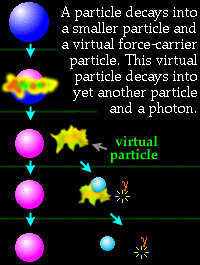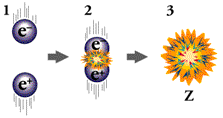This principle can also be written in terms of energy and time:
 In many decays and annihilations, a
particle decays into a very high-energy
force-carrier particle, which almost
immediately decays into low-energy particle.
These high-energy, short-lived particles are virtual particles.
In many decays and annihilations, a
particle decays into a very high-energy
force-carrier particle, which almost
immediately decays into low-energy particle.
These high-energy, short-lived particles are virtual particles.
The conservation of energy seems to be violated by the apparent existence of these very energetic particles for a very short time. However, according to the above principle, if the time of a process is exceedingly short, then the uncertainty in energy can be very large. Thus, due to the Heisenberg Uncertainty principle, these high-energy force-carrier particles may exist if they are short lived. In a sense, they escape reality's notice.
The bottom line is that energy is conserved. The energy of the initial decaying particle and the final decay products is equal. The virtual particles exist for such a short time that they can never be observed.
Most processes among fundamental particles are
mediated by virtual-carrier particles. For example see
neutron beta decay,
the production of charm particles, or the
decay of an eta-c particle.
![]() Click on the "Back" button to return to the decay path
Click on the "Back" button to return to the decay path
or use your browser's "back" button.
Question: If an electron and a positron collide to produce a Z, is the Z a virtual particle?
